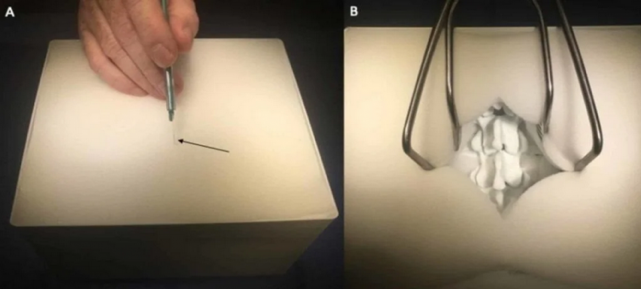此外,随着世界在新冠病毒大流行中陷入停顿,医学院学生无法再参加培训,因为学校叫停了与病人的接触。在美国,超过90,000名医科学生参与到抗击疫情,他们帮助医院执行呼叫中心任务,甚至为前线的医护人员提供托儿服务。即使学生可以在今年重返校园,当前的疫情形势也证明了可携带且独立于医院相关条件的学习工具的重要性。
The recent outbreak has diminished manyneurosurgical learning opportunities throughout the world due to conferencecancellations, decreased operating room utility, and quarantine policies. Inthe study, Clifton and Damon revealed that a simulator design that is easilycreated and portable for dissemination to neurosurgical trainees does not exist. That was something they were eager to develop and share with the medicalcommunity.
由于会议取消、手术室利用率降低和隔离政策,最近的疫情减少了全世界许多神经外科学习机会。在这项研究中,克利夫顿和达蒙表示,目前还没有面向神经外科学生的手术模拟器,面向神经外科学生的模拟器正是他们渴望与医学界分享的东西。
The five co-authors of the paper, includingClifton and Damon, along with Mayo Clinic neurosurgeons Mark Pichelmann, EricNottmeier, and Fidel Valero-Moreno, decided to carry out this project toprovide institutions across the world with a cost-effective, easily available“in-house” model.
该论文的五位共同作者,包括克利夫顿和达蒙,以及梅奥医学中心的神经外科医生马克·皮切尔曼、埃里克·诺特梅尔和菲德尔·瓦莱罗·莫雷诺,决定实施这个项目,为世界各地的医疗机构提供一个成本效益高的模型。
During the study, ten SpineBoxes weresuccessfully printed using acrylonitrile butadiene styrene (ABS) filament on a Raise3D Pro2 Plus fused deposition modeling (FDM) 3D printer. It took the team30 hours and $9.68 of material to print each SpineBox.
在研究过程中,团队在Raise3D Pro2 Plus 熔融沉积成型(FDM) 3D打印机上使用ABS耗材成功打印了10个SpineBox。每个SpineBox,团队花费30个小时和价值9.68美元的耗材。
The team first acquired an anonymized CTscan of the lumbar spine of an adult patient to produce lumbar vertebral modelsthat adequately replicated normal surface anatomy. The CT scan was then uploadedinto the open source 3D Slicer platform, where five lumbar vertebrates (L1-L5) were individually selected, and facet joints and intervertebral spaces weremanually separated to produce individually segmented models of the lumbarvertebrae. Each of the five lumbar vertebral models was then converted into an STL file and uploaded into the CAD software platform Meshmixer, which was alsoused to construct a virtual housing box for the vertebral models. The sliced SpineBox STL file was converted into a G-code to finally be 3D printed.
该团队首先对一名成年患者的腰椎进行CT扫描,以生成能够充分复制正常表面解剖结构的腰椎模型。然后将CT扫描上传到开源3D切片平台,在此平台上分别选择五块脊椎 (L1-L5),手动分离小平面关节和椎间隙以产生腰椎的单独分割模型。五个腰椎模型中的每一个都被转换成STL文件,之后上传到CAD平台Meshmixer,该平台也被用来为脊椎模型构建一个虚拟的盒子。切片后的SpineBoxSTL文件被转换成G-code,最终进行3D打印。
In order to enhance the educationalexperience, the team decided that they would also replicate the soft tissuestructure by creating a soft barrier so that medical trainees wouldn’t see thevertebral model directly, providing a surgical environment that enabled them tooperate in realistic conditions. In this case, they decided to cut flexibleupholstery polyurethane foam sheets to fit the dimensions of the simulatorhousing box (at 17.6 x 18.6 cm). After the assembly was complete, the veryrealistic simulator allowed trainees to cut through the foam with a scalpel anduse surgical retractors to simulate the separation of the soft tissue after theincision, allowing them to see into the operative cavity.

The use of polyurethane foam for soft tissue simulation as in a live operative scenario
聚氨酯泡沫在软组织模拟中的应用,让使用者像在真实手术场景中身临其境
为了增强教育体验,团队决定通过设计一个软屏障来复制人体皮肤软组织结构,这样医学生就不会直接看到脊椎模型,从而提供一个拟真的外科手术环境,使他们能够在更贴近现实的条件下操作。为了实现这个目标,他们需要切割柔性室内装饰聚氨酯泡沫片,以适应模拟器外壳盒的尺寸(17.6 x 18.6厘米)。组装完成后,受训者用手术刀切开泡沫片,并使用手术牵开器模拟切口后软组织的分离后,可以让学生们看到手术腔,非常逼真。
As described in the paper, Clifton and Damon have already begun using CAD design and 3D printing at the Mayo Clinic, in Jacksonville, to construct SpineBox simulators, which are also disposable and able to replicate the cortico-cancellous interface for pedicle screw placement.
正如论文所述,克利夫顿和达蒙已经开始在杰克逊维尔的梅奥诊所使用CAD和3D打印技术来制作“SpineBox”模拟器,模拟器是一次性的,能够复制用于椎弓根螺钉固定手术的皮质-松质骨界面。
- 还没有人评论,欢迎说说您的想法!



